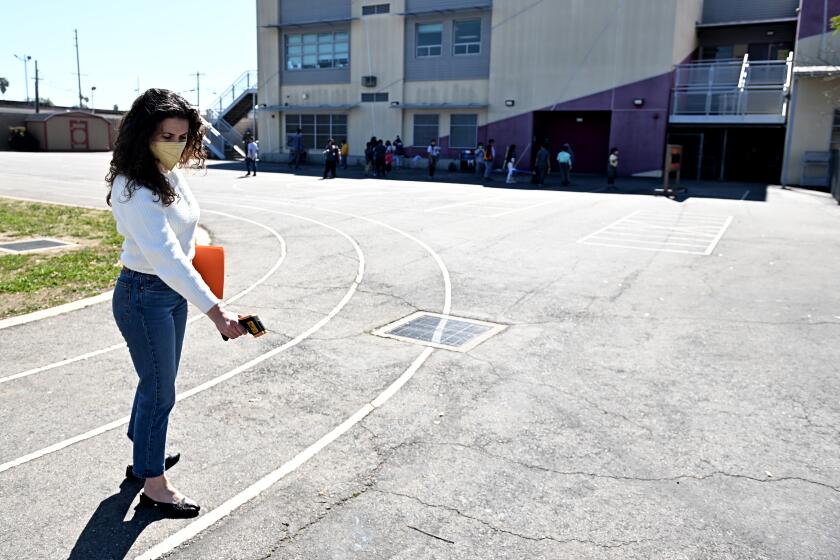Price of Water Expected to Triple in State in the ‘90s : Drought: Supplies are shrinking and demand is growing. Environmental costs also are on the rise.
Water is fast changing from an inexpensive commodity to one of the most costly utilities on the household budget as officials seek to tap new supplies and meet federal requirements to improve the quality of drinking water.
Even with periods of normal rainfall, water experts believe, bills will triple in the 1990s.
“By the end of this decade, you will see the bills coming due,” said John Fraser, director of the Assn. of California Water Agencies. “Water bills of $100 a month will not be unusual for people in Southern California.”
Some Southern Californians may get a preview of the higher prices this summer when bills reflecting penalties for excessive use begin to arrive. At the same time, local water agencies are raising rates to compensate for the revenue they have lost as customers use less water. In parts of California, proposed increases of 30% already are on the table.
Protections for endangered species of fish and wildlife also will continue to add to rising prices by limiting the amount of water that can be taken from rivers, water experts say.
The most basic reason for the price increases is simple: as the population grows, demand increases, but the water supply is finite. That supply and demand equation, and its effect on price, has come into focus in this water-short year.
In normal years, the Metropolitan Water District pays $250 an acre-foot for State Water Project water, and sells it wholesale to districts that serve about half the state’s population. To supplement its supply this year, the MWD will pay $330 an acre-foot to buy and ship water from the emergency Water Bank. An acre-foot fills the needs of a Los Angeles family of five for about 18 months.
By the end of the decade, the MWD will be charging its customers $600 an acre-foot for water, more than twice the current level, predicts Wiley Horne, the department’s director of planning.
“We’ve got a reservoir to build. We’ve got pipelines to build. We have treatment plants to build and improve,” Horne said.
Other examples abound of what is in store for water prices across California:
* In Monterey, water officials are considering spending $35 million for a desalination plant and pipeline. That could raise water prices by 35%, said Dale Hekhuis, chair of the Monterey Peninsula Water Management District, which typically charges residential users $17 a month. This would be in addition to a proposed 30% rate increase to cover higher operating costs.
* In the Coachella Valley, water bills will “double or triple” if the district must meet anticipated federal drinking water standards requiring the removal of almost all radon, a naturally occurring radioactive element, said Dale Bohnenberg, an engineer with the Coachella Valley Water District.
* In Los Angeles, officials say consumers can expect annual increases of about 10% during the 1990s, as the Department of Water and Power looks to increase its supply. Such increases would raise Los Angeles residential water bills, which now average $25 a month, to over $60 a month within 10 years.
“I don’t think it’s going to get better. It’s going to get worse,” said Mike Gage, president of the DWP commission. He expects water rate increases akin to what happened to petroleum prices two decades ago.
Related costs also are going up. Los Angeles’ sewage treatment and disposal rates are rising about 25% a year, said DWP engineer Jerry Gewe. This year, the department’s sewage charges for customers will surpass the cost of drinking water, he said.
Californians generally pay less for water and use more of it than people in most of the rest of the country. Most people pay a small fraction of their incomes for water. Even in these dry times, bills in parts of California are under $10 a month. The average California household’s water bill is $21.30 a month, a Department of Health Services study shows. Cable television bills, by comparison, commonly top $35, as do electric bills.
At such prices, it’s little wonder that water is wasted.
Earlier this year, it was revealed that because of green-thumbed gardeners and leaky plumbing at a swimming pool, Gov. Pete Wilson’s residence consumed 69,000 gallons in two months--more than 20 times the ration for families at the time in Marin County and Santa Barbara, two of the driest parts of state.
But while the volume raised eyebrows at the state Capitol, the charge attracted nary a notice. The Arcade Water District billed its most prominent customer roughly $20 for all that water, General Manager Walt Libal said.
With its proximity to the American River and ample ground water, Arcade may have the least expensive water in California. Arcade customers, most of whom have no water meters, pay a flat fee of $5.24 a month.
“It’s reaching a point where the commodity is taken for granted,” Libal said, estimating that Arcade’s customers use 200 cubic feet of water a day, or 1,496 gallons, while the national average is 160 cubic feet. “Things have got to change.”
And change they will. In the next 10 years, Libal estimated, bills will triple--at least. One reason will be the cost of complying with federal safe drinking water standards.
The Department of Health Services estimates that statewide, compliance with the federal Safe Drinking Water Act will cost $2 billion--though proponents of the safeguards contend that such estimates are far too high.
Safe Drinking Water Act regulations due out in coming months and years will seek to eliminate from tap water almost all traces of radon and other agents that can cause cancer, intestinal ailments or other maladies.
On Tuesday, the Environmental Protection Agency, seeking to comply with the act, announced that utilities must treat water with anti-corrosion chemicals to inhibit lead from leaching out of water lines and brass fixtures.
Lead ingested from paint chips, drinking water and other sources lowers intelligence in tens of thousands of preschoolers annually. The EPA estimates the nationwide cost of complying with the rule, which will require agencies to monitor tap water in some homes, will be up to $800 million a year.
California officials say that while there are few lead water lines in the state, many districts will have to add lime or other substances to water to stop lead from leaching into drinking water.
“When all of the new rules are adopted, the average water bill will go up anywhere from $10 to $50 a month,” said Peter Rogers, of the health department’s Office of Drinking Water.
Agencies that have never filtered their water may need to build treatment plants. San Francisco, for one, may have to build a plant to filter out such protozoa as giardia, which causes diarrhea, even though there has never been an outbreak traced to its Hetch Hetchy reservoir in the Sierra.
Such a facility’s price tag could be $450 million, spread among 2 million Hetch Hetchy customers, Rogers said. San Francisco water officials estimate the cost of treating Hetch Hetchy, now about $7 per million gallons, could shoot up to $150 per million gallons.
As high as treatment costs may be, the cost of finding more water could be even greater. After five years of low rainfall, some water experts talk of dusting off plans for new reservoirs and aqueducts, even the Peripheral Canal at the Sacramento-San Joaquin River Delta.
Fraser of the Assn. of California Water Agencies advocates a 2.5-million acre-foot Los Banos Grandes reservoir in Central California; a below-ground reservoir for 1 million acre-feet of Delta water in the Kern River basin, and the oft-rejected Auburn Dam on the American River.
But Thomas Graff of the Environmental Defense Fund said major water projects are unlikely to come, adding: “The economic and political and environmental obstacles are too formidable to proceed down that road.”
Graff contends that urban areas can fill their needs far more cheaply by buying water from farmers. Farmers now are selling water to the Water Bank for $125 an acre-foot. An acre-foot produced by a desalination plant, for example, would cost $1,900.
If the State Water Project itself does not expand, its price for water will remain stable, according to state Department of Water Resources officials.
Whether there are major new state projects, local water agencies are embarking on smaller-scale projects that will increase prices locally.
Santa Barbara, for example, is turning to the ocean. Its desalinated water will cost more than three times the water from its traditional sources. Bills that were $5 or $10 a month a few years ago could hit $50 or $60 a month 10 years from now, said Bill Ferguson of the Santa Barbara Public Works Department.
From Encinitas to Oakland, officials know that with environmental concerns, green lawns will lose out to the needs of fish and wildlife.
A district that has tried to heed such concerns is the East Bay Municipal Utilities District. Last year, when its source of water, the Mokelumne River, ran especially low, the district doubled the amount of water it released from its reservoirs--at a cost of $1 million.
The hope was that the extra 13,000 acre-feet would allow more salmon to swim upstream to spawn. As it turned out, only 400 salmon made the trip. But fisheries experts will try new techniques to meet the East Bay district’s goal of 20,000 spawning salmon, spokesman Gayle Montgomery said.
“We have to be prepared to give more water back to the environment,” he said. Still, for every percentage point that the people conserve, the East Bay district loses $1 million in revenue. This year, the district is asking its 1.2 million customers to cut their usage by 15%. “The more you conserve,” Montgomery noted, “the more it costs.”
More to Read
Start your day right
Sign up for Essential California for news, features and recommendations from the L.A. Times and beyond in your inbox six days a week.
You may occasionally receive promotional content from the Los Angeles Times.






